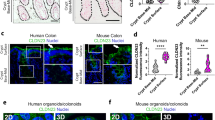Abstract.
Elevation in intracellular Ca2+ acting via protein kinase C (PKC) is shown to regulate tight junction resistance in T84 cells, a human colon cancer line and a model Cl− secretory epithelial cell. The Ca2+ ionophore A23187, which was used to increase the intracellular Ca2+ concentration, caused a decrease in tight junction resistance in a concentration- and time-dependent manner. Dual Na+/mannitol serosal-to-mucosal flux analysis performed across the T84 monolayers treated with 2 μm A23187 revealed that A23187 increased both fluxes and that in the presence of ionophore there was a linear relationship between the Na+ and mannitol fluxes with a slope of 56.4, indicating that the decrease in transepithelial resistance was due to a decrease in tight junction resistance. Whereas there was no effect of 0.1 μm A23187, 1 or 2 μm produced a 55% decrease in baseline resistance in 1 hr and 10 μm decreased resistance more than 80%. The A23187-induced decrease in tight junction resistance was partially reversible by washing 3 times with a Ringer's-HCO3 solution containing 1% BSA. The A23187 effect on resistance was dependent on intracellular Ca2+; loading the T84 cells with the intracellular Ca2+ chelator BAPTA significantly reduced the decrease in tight junction resistance caused by A23187. This intracellular Ca2+ effect was mediated by protein kinase C and not calmodulin. While the protein kinase C antagonist H-7 totally prevented the action of A23187 on tight junction resistance, the Ca2+/calmodulin inhibitor W13 did not have any effect. Sphingosine, another inhibitor of PKC, partially reduced the A23187-induced decline in tight junction resistance. The PKC agonist PMA mimicked the A23187 effect on resistance, although the effect was delayed up to 1 hr after exposure. In addition, however, PMA also caused an earlier increase in resistance, indicating it had an additional effect in addition to mimicking the effect of elevating Ca2+. The effects of a phospholipase inhibitor (mepacrine) and of inhibitors of arachidonic acid metabolism (indomethacin for the cyclooxygenase pathway, NDGA for the lipoxygenase pathway, and SKF 525A for the epoxygenase pathway) on the A23187 action were also examined. None of these agents altered the A23187-induced decrease in resistance. Monolayers exposed to 2 μm A23187 for 1 hr were stained with fluorescein conjugated phalloidin, revealing that neighboring cells did not part one from another and that A23187 did not have a detectable effect on distribution of F-actin in the perijunctional actomyosin ring. The results indicate that elevation in intracellular Ca2+ decreases tight junction resistance in the T84 monolayer, acting through protein kinase C by a mechanism which does not involve visible changes in the perijunctional actomyosin ring.
Similar content being viewed by others
Author information
Authors and Affiliations
Additional information
Received: 14 July 1995/Revised: 25 September 1995
Rights and permissions
About this article
Cite this article
Tai, YH., Flick, J., Levine, S. et al. Regulation of Tight Junction Resistance in T84 Monolayers by Elevation in Intracellular Ca2+: A Protein Kinase C Effect. J. Membrane Biol. 149, 71–79 (1996). https://doi.org/10.1007/s002329900008
Issue Date:
DOI: https://doi.org/10.1007/s002329900008




